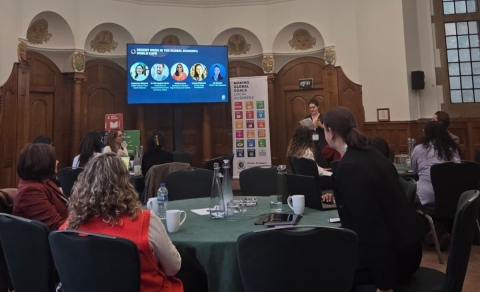Lecture held at Sciences Po, Paris School of International Affairs
Breaking the cycle of debt crisis: How a new Stimulus Plan and the existing multilateral system can help
23 FEBRUARY, 2023

As prepared for delivery
Distinguished Professors, Ladies and Gentlemen, Dear Students. It is a great pleasure to join you today.
We are living through troubled times: the continuing socioeconomic shockwaves of COVID-19; a devastating cost-of-living crisis tipping millions of people into poverty; an escalating climate crisis. Europe is once again the stage for a major war.
And around the world, a debt crisis is growing, threatening the ability of developing countries to invest in the services and infrastructure that they need for their people.
Two data points:
- 25 developing economies are currently spending over 20% of their government revenues on debt servicing -- about where we were in 1996, when the IFIs embarked on a global debt relief programme that eventually included 39 low-income economies (the HIPC agreement).
- Sovereign bond yields are now over 10 percentage points above US treasury yields for more than 14 countries and over 6 percentage points in 21 countries. Paying 10 or 14% percent interest on sovereign bonds is no longer an odd occurrence -- and effectively locks dozens of economies out of capital markets. Indeed, for some of the world’s poorest nations, debt service payments skyrocketed by 35% in 2022.
Countries struggling to keep up with debt payments will not be able to invest in the Sustainable Development Goals and climate action for years. Further, capital markets will lock developing economies out of new finance they need to move forward.
What can be done? Multilateral solutions
The debt crisis is a systemic, global problem, demonstrating the urgency of the call in Our Common Agenda’s for a stronger, more networked and inclusive multilateral system, anchored within the United Nations. Such a system has a fundamental role in helping to manage and resolve the crisis, in line with the principles of the UN Charter.
As an example of how this can work, last week, UN Secretary-General António Guterres launched a bold new SDG Stimulus Plan. It outlines a $500 billion annual stimulus for sustainable development. It urges G20 finance ministers to act quickly.
A three-point plan to begin responding to systemic risks proposes to inject liquidity, restructure sovereign debt, and lower the cost of long-term lending to developing economies.
The plan reflects the reality that the current global financial system, designed to buffer periodic shocks in the aftermath of two world wars, is not adequate in an era of multiple crises all at once.
A new international financial architecture - a “Bretton Woods 2.0”- must ensure that finance is systematically aligned with and invested in just, inclusive and equitable development in all countries.
UNDP launched a report today, Building Blocks Out of the Crisis. It provides granular data on the SDG Stimulus. Its most important message is that we cannot solve the debt crisis through “relief parachuting in from rich countries”. The composition of debt has shifted. Capital markets have also changed.
Multilateral and bilateral creditors - like the World Bank and the French government- are key players in debt resolution for low-income economies. Key players for middle-income countries, where most of the problem lies, are private creditors, bondholders from pension funds and mutual funds, and the government of China and other non-traditional creditors.
In the 1990s, the Heavily Indebted Poor Countries (HIPC) agreement allowed 39 economies to reduce their debt burdens (“a haircut” of 30% or 40% of their debt stock) from bilateral creditors.
In the 1980s, Brady Bonds issued by the US Treasury allowed 23 economies to reschedule their debt with investment banks.
We will likely need a combination of both techniques this time around. A HIPC agreement plus a Brady Bond 2.0 endorsed by the G7 and China.
UNDP’s latest analysis projects that a 30% haircut of debt stock could free up to $148 billion in foregone debt service payments. Distressed bonds are already trading at 40 to 50 cents to the dollar. A 30% haircut is likely to be a better deal than what the market can offer.
We also estimate that if 40% of new financing was done at near concessional rates (not 10 but 4%), economies could save up to $120 billion in foregone interest rate payments. Rather than having developing economies turn to capital markets at 10 or 14% rates, why not have multilateral development banks tap the market at 4% and pass lower rates on to developing economies?
This would free resources to accelerate sustainable development through investment in energy transitions, social protection, new jobs, health and education, etc.
What can be done? Country solutions
Developing countries are not waiting for change to happen. A promising thread is a newfound appreciation of risk and risk-adjusted insurance and lending -- so-called “state-contingent financial instruments”.
Mexico issued SDG-linked bonds that tie financing to local actions to close SDG gaps in education, gender, and health, and so on. This creates a direct link between finance and development impact.
Uruguay’s $1.5 billion sovereign sustainability-linked bond issued last October is tied to climate and nature with demand outstripping supply. Its innovative ‘step-up, step-down’ mechanism sets the interest rate based on the country reaching nationally defined climate goals.
Barbados has issued a pandemic-protected bond and Grenada included a hurricane clause in one of its bonds. Both pause payments if shocks negatively affect GDP growth.
These countries have skillfully responded to mounting demand for sustainability-linked financial instruments. They are unlocking finance, enhancing accountability, accelerating climate action, and improving the lives of their people.
Some hope that ESG rankings could achieve similar ends. But too many companies are simply playing the numbers. This is leading to ‘greenwashing’ and massive flows to some of the richest companies in the world, rather than to emerging market investments most in need of finance.
A challenge for leaders in many countries -- developing & developed -- is to look at how their economies, financial systems and energy systems can best anticipate and support decarbonization.
India offers an interesting example. Years ago, it seemed unlikely that the country set to be the world’s most populous nation could transition at scale. Yet India’s solar and wind energy sectors are not only advancing the energy transition but opening new job options. They employed 164,000 workers in the 2022 fiscal year, a 47% increase over the previous year. By 2030, these sectors alone could employ 1 million workers. A Skills Council for Green Jobs in India has so far trained 500,000 people to work in green businesses.
To move forward, we need multilateral solutions that match country solutions. Multilateral action remains critical to respond to systemic, global risks and to leaving no country behind.
We need financial assurances, guarantees, debt-for-nature and debt-for-climate swaps, State-contingent instruments as well as collective action clauses on the debt side. Progress depends on de-risking, leveraging capital markets, implementing new capital adequacy rules, issuing subordinate debt and securitizing private sector assets on the financing side.
A HIPC agreement combined with a Brady Bond agreement and a de-risking mechanism to shave 6 to 10 percentage points off borrowing costs for developing economies could realize the SDG Stimulus Plan’s ambition to add $500 billion in lending capacity by 2025.
I have not yet mentioned the word ‘taxpayers’. There are many ways to leverage existing private and public flows within the existing financial architecture.
We will take this call for action to the G20 Finance Minister’s meetinglater this week. We will work with Prime Minister Mottley in May to continue galvanizing energy from the Bridgetown Initiative. We will join President Macron’s Summit here in June and prepare for our own SDG Summit in September 2023.
UNDP itself has made an aspirational commitment to promote the alignment of over $1 trillion of public expenditure and private capital investment with the SDGs by 2025.
Let me conclude with some thoughts from re-reading some books on ethics and normative concerns. What We Owe Each Other by Minouche Shafik. What We Owe the Future by William Macaskill. There are many thought - provoking ideas from the Effective Altruism movement. Ethical commitments plus decisive political action plus effective financial instruments are all part of the equation.
The 2030 Agenda was never designed solely for developing countries. It emerged from debate and consensus among UN Member States. Events since then have simply reminded us that “all of us in the problem” requires “all of us in the solution”.
This depends on an inclusive multilateral system anchored in the UN. And on actively listening to voices from the Global South, and from environmental, climate and youth movements.
Crucially, it implies continuing to think about development as ‘freedom’. We must approach the future not just in terms of development or development aid, but as a co-investment in each other.
Dear students, transformations are inevitable. I look to the intellect, passion, and ingenuity of young people to shape transformations that are just, sustainable, and frankly, accessible for all. You are part of the largest generation of young people in history. The career choices that you now make will have a considerable impact on the future.
As you do so, keep in mind that from the ashes of two devastating wars, the United Nations promised a better world. To emerge from our own ‘age of uncertainty’, all of us have a duty to stay true to the letter and spirit of the UN Charter, which begins with “We the Peoples”. That now means taking the reins and strengthening the multilateral system so that we can come together and realize a future that that works for all peoples, the planet and future generations.












